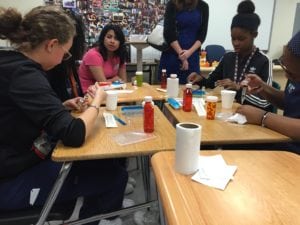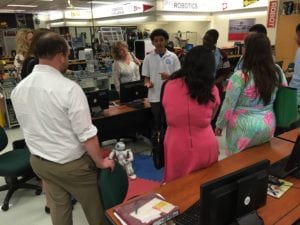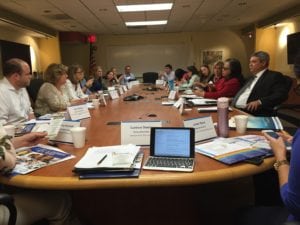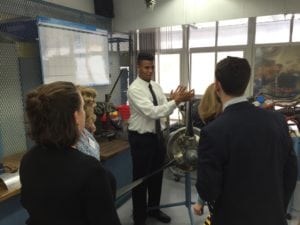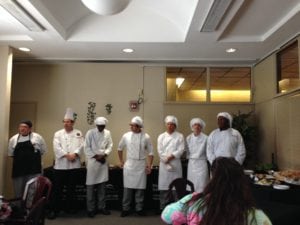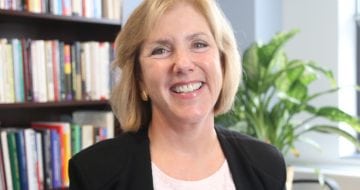By Carinne Deeds and Zachary Malter
On May 31st and April 1st, 2016, AYPF staff and a group of congressional staff and national education leaders visited Miami to explore the city’s robust and comprehensive system of career pathways. We visited three unique career-focused schools: Miami Lakes Education Center and Technical College (serving high school students and adults), Hialeah Gardens High School (a neighborhood school serving high school students), and George T. Baker Technical College (serving high school students and adults exclusively in technical training).* Below are 5 major takeaways from the trip.
1. Career Pathways Involve Hands-on Learning with High Student Engagement
Students in structured career pathways are often engaging in hands-on activities that excite them about learning. At George T. Baker Technical College, students learn welding as a component of aviation mechanics. At Hialeah Gardens Senior High Schools, students run a small farm on the school grounds that nurtures rabbits and chickens, and students in the medical academy learn how to properly insert IV needles. These learning experiences have the dual benefits of helping students prepare for a meaningful career, while also immersing them in an engaging learning process.
2. Career and Technical Education Involve the Careers of the Future
Career and technical education (CTE) is no longer confined to woodshop, home economics, and other occupations often viewed as low-wage. Rather, students are learning about careers in robotics, hydroponics, and avionics through their classes. At Miami Lakes Educational Center, students program robots to walk and speak, while others students design circuit boards and program 3D printers to help them understand engineering. In Miami and other innovative cities, career pathways programs give students exposure to emerging fields that fall far outside old definitions of CTE.
3. Career Pathways Need Supportive Leaders, Partners, and Policies
Miami-Dade County Public Schools has a strong group of leaders and partners who drive the success of the school district’s Career Pathways Initiative. Alberto Carvalho, the school district Superintendent, Robert Gornto, Assistant Superintendent for School Operations, and Lupe Diaz, Executive Director, Department of Career and Technical Education, among others, provide supportive leadership at the district level. They work in conjunction with partners at the city’s leading public universities, Miami Dade College and Florida International University, Career Source South Florida and other workforce agencies, industry partners, and corporate leaders such as JP Morgan Chase, whose New Skills at Work Initiative helped stimulate career pathways. School-level principals also prioritize career and technical education, making sure it is a lived reality for their students.
4. Career Pathways Are Successful When High Expectations Are Set for Students
High expectations are critical in CTE programs and within other elements of career pathways. At George T. Baker Technical College, administrators set high expectations for students so that they have the skills to repair airplanes that are safe to fly. Students at Baker not only have to meet academic standards for the state of Florida, they also must score a 100% on the Federal Aviation Administration certification test – a much higher standard than most traditional schools. It is no surprise that at each school, the students themselves led tours of their campuses and took ownership over their projects. When students take on leadership roles, they gain the professional and personal skills necessary to supplement the technical skills of their future career.
5. Career Pathways Allow Students to Do Work that Supports Their Community
Much of the work that students engage in during CTE courses involves producing something that directly gives back to their communities. For instance, culinary arts students at Miami Lakes Education Center cook food that is served daily to students and staff. Students in the education academy at Hialeah Gardens High School operate an onsite preschool, caring for their community’s children while gaining hands-on experience working in a classroom. Miami students in various CTE programs also learn procedures that are essential to keeping people healthy and safe both on the ground and in the air. Students learn the importance of service and of applied learning at the same time as they prepare for meaningful future careers.
As new research that reveals the benefits of CTE emerges, more schools and districts will most likely be interested in designing and enhancing career pathways systems. Even the federal government has been wrestling with expanding CTE through recent efforts to re-authorize the Carl D. Perkins Career and Technical Education Act, which currently provides approximately $1.1 billion for Career and Technical Education Programs. Policymakers can learn a great deal from Miami’s Career Pathways system and its positive impact on both students and the greater community.
* Miami Lakes Educational Center and Hialeah Gardens High School are both NAF-affiliated academies.
Carinne Deeds is Policy Associate at the American Youth Policy Forum, and Zachary Malter is a Policy/Research Assistant at the American Youth Policy Forum.



